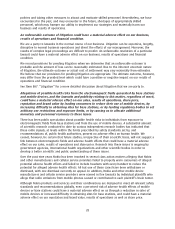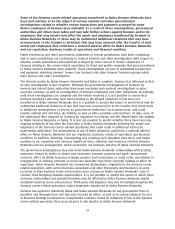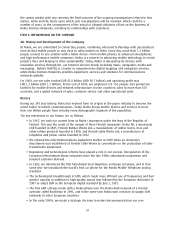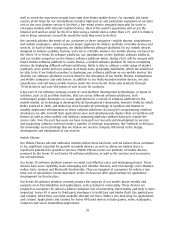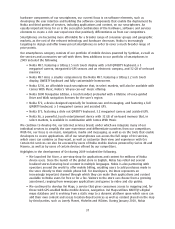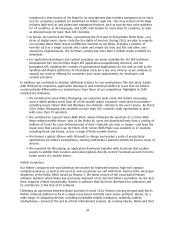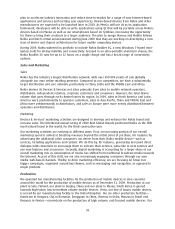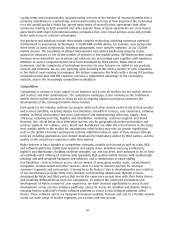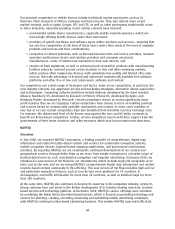Nokia 2009 Annual Report Download - page 38
Download and view the complete annual report
Please find page 38 of the 2009 Nokia annual report below. You can navigate through the pages in the report by either clicking on the pages listed below, or by using the keyword search tool below to find specific information within the annual report.New additions to our portfolio of mobile phones in 2009 included the following.
• Nokia 2323 classic, an affordable mobile device offering an FM radio with recording and an
Internet browser.
• Nokia 2330 classic, an affordable mobile device equipped with an integrated camera.
• Nokia 3720 classic, a rugged handset designed to resist water, dust and shock.
• Nokia 5130 XpressMusic, an affordable handset optimized for music and equipped with a 2
megapixel camera.
• Nokia 6303 classic, featuring a 3.2 megapixel camera, an Internet browser and long battery
life.
• Nokia 6700 classic, equipped with a 5 megapixel camera, assisted GPS navigation and high
speed data access.
• Nokia X3, an affordable music device with stereo speakers, builtin FM radio and a 3.2
megapixel camera.
To create additional value for users of our Series 30 and Series 40based mobile phones, we also offer
a range of services that can be accessed with them. One such service is Nokia Life Tools, which
enables consumers to access timely and relevant agricultural information, as well as education and
entertainment services, without requiring the use of GPRS or Internet connectivity. During 2009, we
launched the service in India and Indonesia, and we plan to introduce the service to additional
emerging markets during 2010.
Nokia has also developed Ovi Mail, a free email service designed especially for users in emerging
markets with Internetenabled devices. The service can be set up and accessed without ever needing
a PC. Ovi Mail launched in late 2008, and by March 2010 more than 6 million accounts had been
activated. Ovi Mail is one of a number of Ovibranded services that users of Nokia Series 40powered
mobile phones can access. More information about these Ovibranded services can be found in the
description of our Smartphones subunit below.
During 2009, Nokia introduced Nokia Money, a new mobile financial service. The service is targeted to
be rolled out gradually to selected markets in 2010 and will be operated in cooperation with Obopay, a
leading developer of mobile payment solutions, in which Nokia has invested. Through the service,
people will be able to use their mobile device to manage their personal finances, pay for products or
services, as well as add credit to their mobile account. In February 2010, Nokia commenced a
commercial pilot in Pune, one of the largest metropolitan areas in India, in partnership with YES BANK.
Smartphones
Our Smartphones subunit brings a range of services and advanced smartphone technologies to a
broad group of consumers, addressing the market for featurerich mobile devices offering Internet
access, entertainment, locationbased and other services, applications and content. Our smartphones
are advanced mobile devices optimized for creating, accessing, experiencing and sharing multimedia
as well as business use. They are powered by Symbian, a software platform which supports a wide
array of functionalities, and provides opportunities for the development of sophisticated applications
and content by third parties. Symbian OS, used by Nokia and others in the industry, is the market
leading software platform for smartphones and has been developed by the Symbian Foundation, a
nonprofit entity, into an open and unified platform. Symbian OS became fully open source and
royaltyfree in February 2010. In other words, Symbian’s source code is available at no cost, and any
individual or organization can now take, use and modify the code for any purpose, whether for a
mobile device or for something else entirely.
With smartphones, we capture value from traditional singlepurpose product categories, including
music players, cameras, pocketable computers, gaming consoles and navigation devices, by bringing
combinations of their various functionalities into a single device. While we continue to develop the
36




